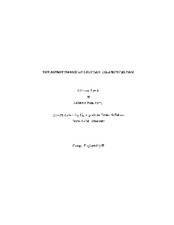| dc.contributor.advisor | Hyman, William A. | |
| dc.creator | Ferry, Katheryn Irene | |
| dc.date.accessioned | 2013-02-22T20:40:08Z | |
| dc.date.available | 2013-02-22T20:40:08Z | |
| dc.date.issued | 1998 | |
| dc.identifier.uri | https://hdl.handle.net/1969.1/ETD-TAMU-1998-Fellows-Thesis-F49 | |
| dc.description | Digitized from print original stored in HDR. Due to the character of the original source materials and the nature of batch digitization, quality control issues may be present in this document. Please report any quality issues you encounter to digital@library.tamu.edu, referencing the URI of the item. | en |
| dc.description | Includes bibliographical references: leaves 20-21. | en |
| dc.description | Program year: 1997/1998 | en |
| dc.description.abstract | Although numerous surgical procedures have been designed to restore stability of a ruptured cranial cruciate ligament (CrCL), the technique for reconstruction has not been perfected. Graft failure due to excessive strain is a serious complication in most reconstructive procedures. This complication has led to the development of an isometric graft placement technique in which the graft is positioned to maintain a constant length and tension throughout passive joint motion. In this project, a two-dimensional model of the stifle joint was created to explore the existence of near-isometric CrCL graft attachment sites. A lateral view of the stifle joint was illustrated using Working Model 3.0, a two-dimensional simulation software package. The geometry of the articulating surfaces of the femur and tibia, origin and insertion points of relevant ligaments, and attachment points of relevant muscles were determined using radiographs of a canine specimen. The ligaments were represented as linear springs and the muscles were represented as non-rotating forces. Nine simulations were produced, each testing a different combination of CrCL origin and insertion points. It was determined that an attachment site inferior and proximal to the original insertion and origin points, respectively, produced the least strain variation in the ligament. | en |
| dc.format.extent | 23 pages | en |
| dc.format.medium | electronic | en |
| dc.format.mimetype | application/pdf | |
| dc.language.iso | en_US | |
| dc.rights | This thesis was part of a retrospective digitization project authorized by the Texas A&M University Libraries in 2008. Copyright remains vested with the author(s). It is the user's responsibility to secure permission from the copyright holder(s) for re-use of the work beyond the provision of Fair Use. | en |
| dc.subject | cranial cruciate ligament | en |
| dc.subject | reconstruction | en |
| dc.subject | graft attachment site | en |
| dc.subject | near-isometric | en |
| dc.subject | strain variation | en |
| dc.title | The biomechanics of cruciate ligament repair | en |
| dc.type | Thesis | en |
| thesis.degree.department | Industrial Engineering | en |
| thesis.degree.grantor | University Undergraduate Research Fellow | en |
| thesis.degree.name | Fellows Thesis | en |
| thesis.degree.level | Undergraduate | en |
| dc.type.material | text | en |
| dc.format.digitalOrigin | reformatted digital | en |


